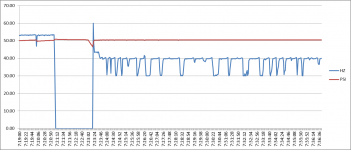What is 'stable'?
The feedback is via 4-20 transducer.
PSI is very stable at += .05 but Hz varies, by 10 in the same time frame.
Stable just means that it approaches a steady condition in the long run, that has the output following the input signal of the controller, where you desire it to end up. As opposed to unstable, which means errors from the input signal are exacerbated, and the output gets farther and farther away.
The middle ground to this, is marginally stable, which means it oscillates around the desired state, and the amplitude of the oscillations remains constant.
There are plenty of behaviors that all classify as stable, but some make for a better controller configuration than others. Such as rise time, overshoot, settling time, and steady state error, all of which you try to minimize, so that the output gets to the desired state as fast as possible, and stays there. But since you can't necessarily minimize all of these at once, you "pick your battles" based on what is best for your application. Sometimes, any overshoot is unacceptable, so you aim to be as close to critically damped as you can, and stay on the overdamped side within real world tolerances. Other times, a barely-noticeable overshoot is acceptable, and you choose such a design, because it helps you achieve a better rise time and settling time.


